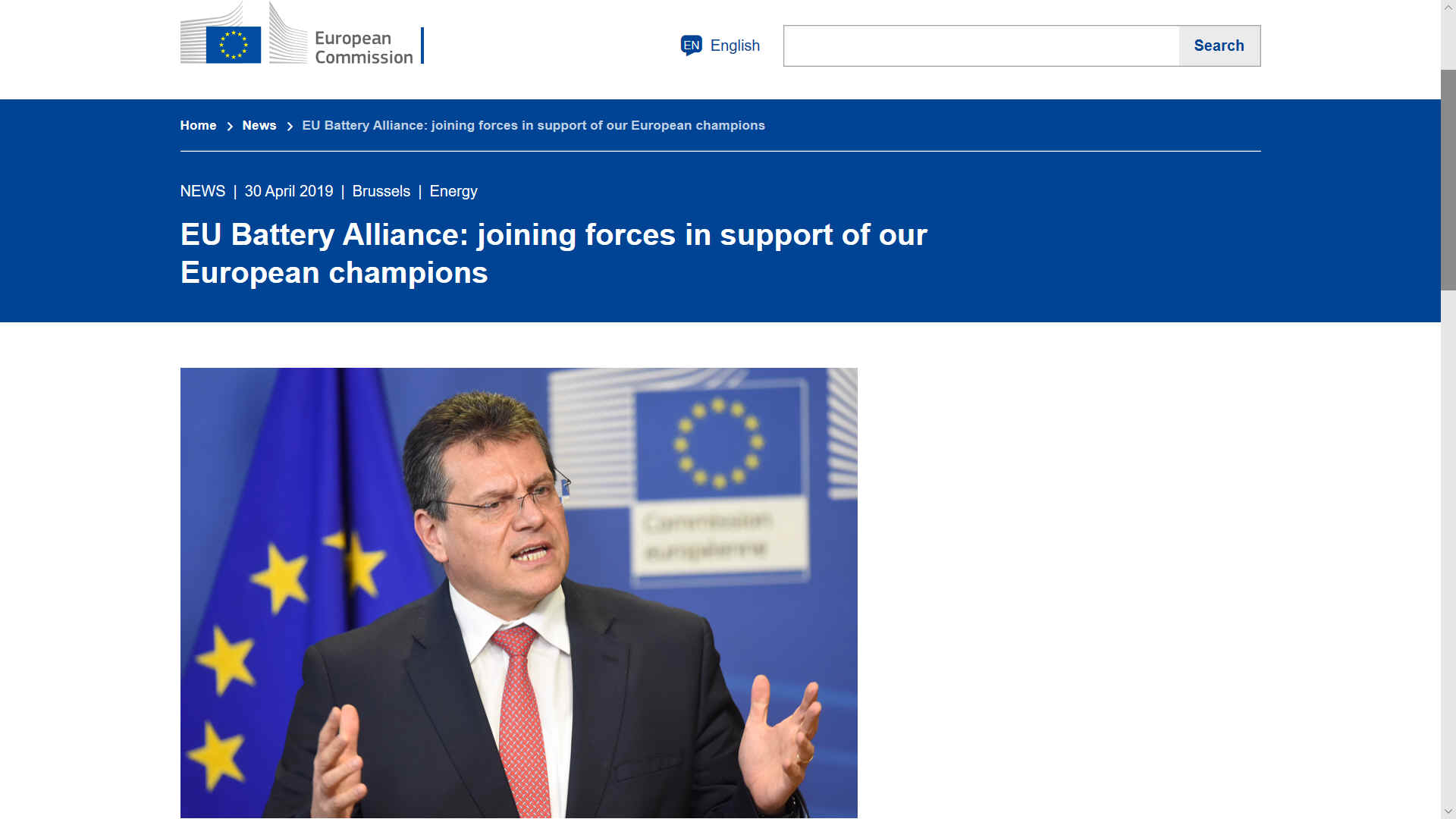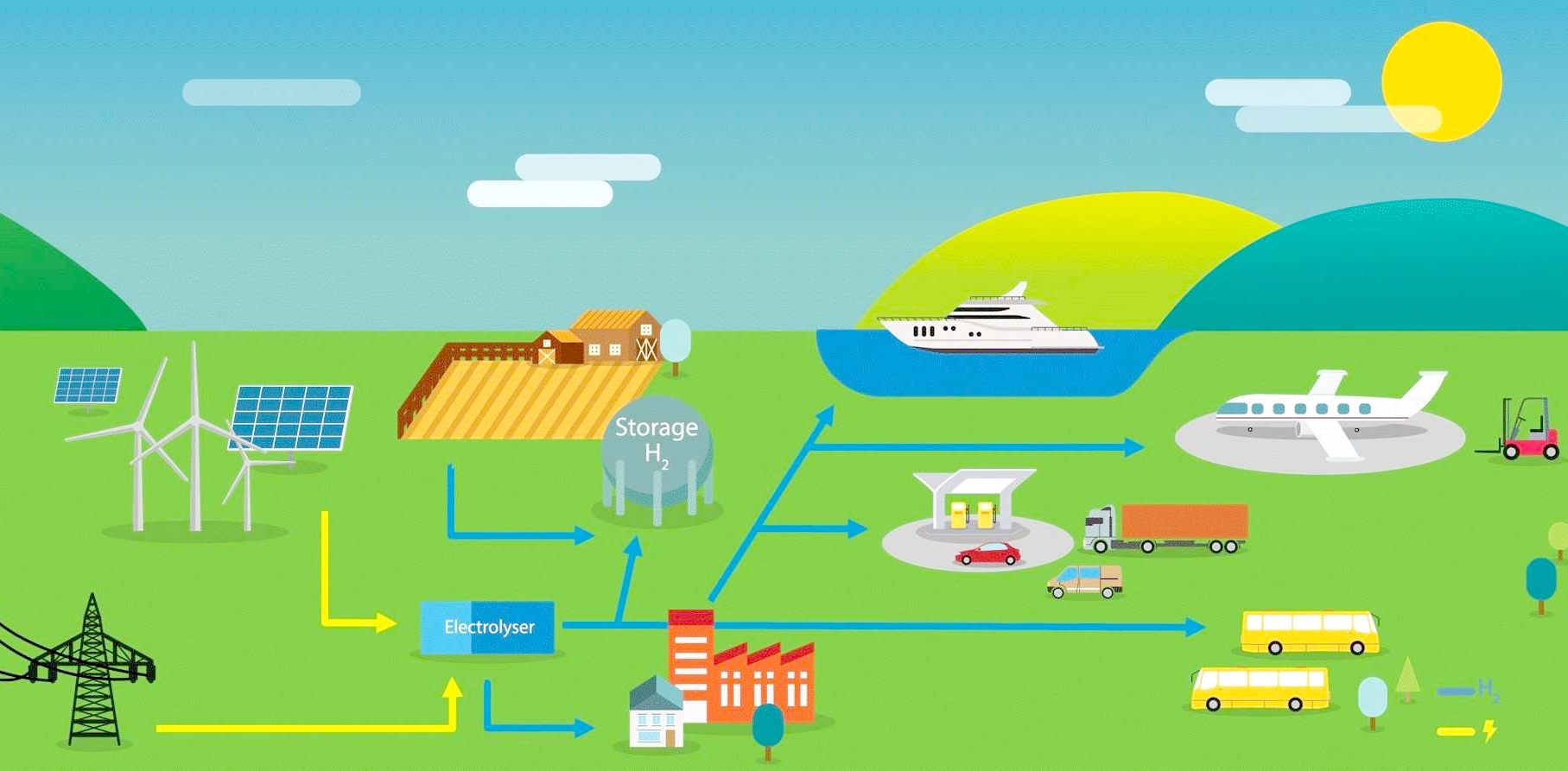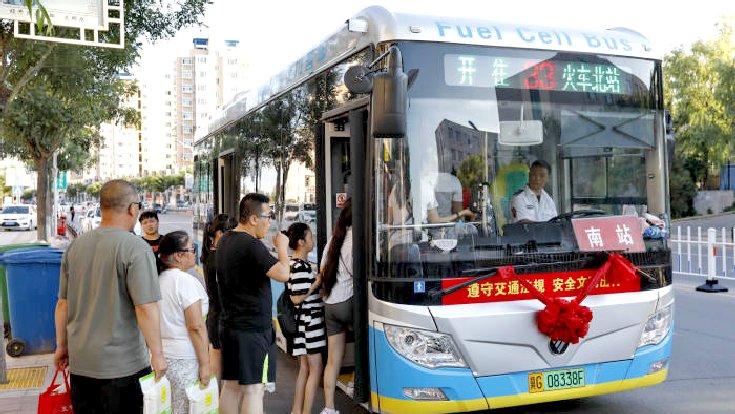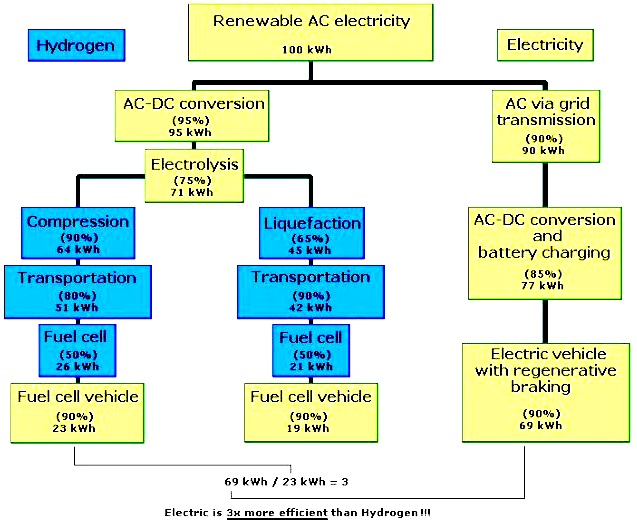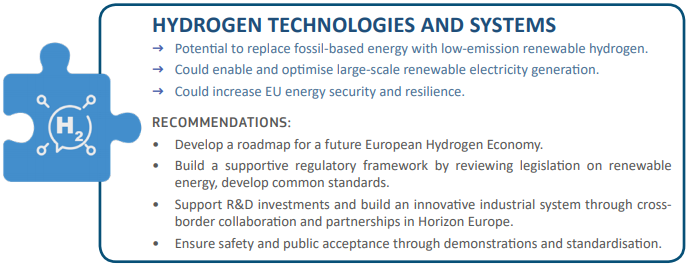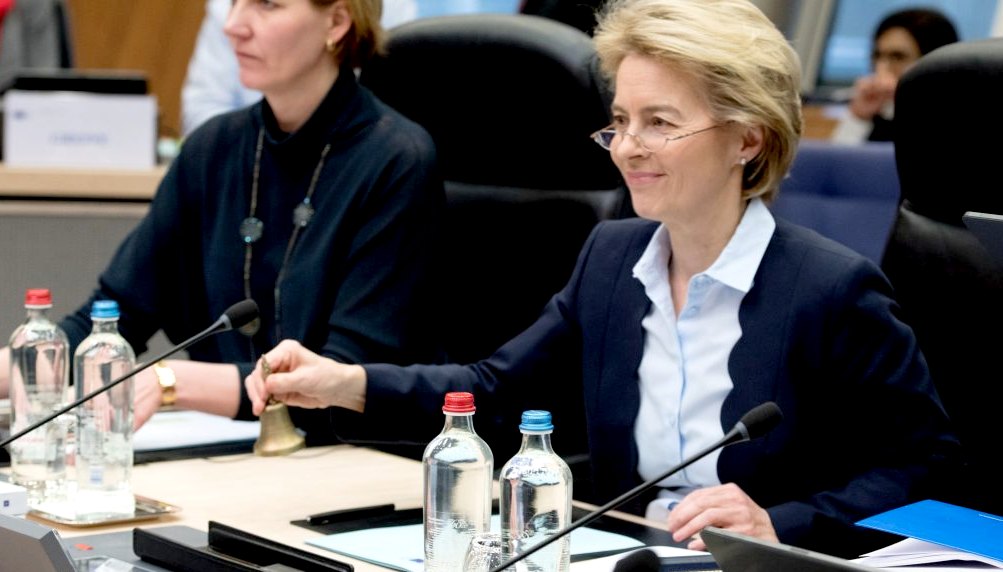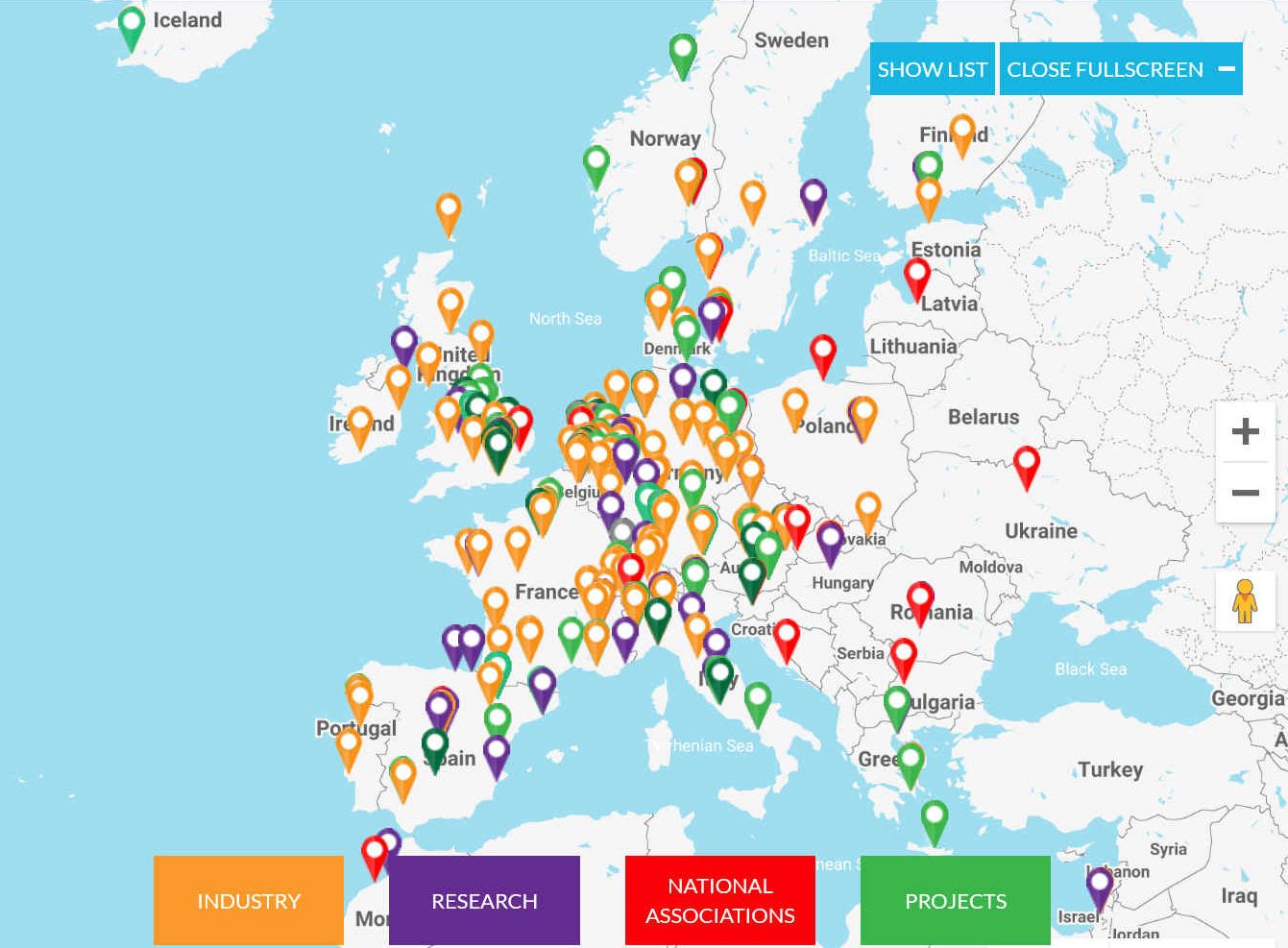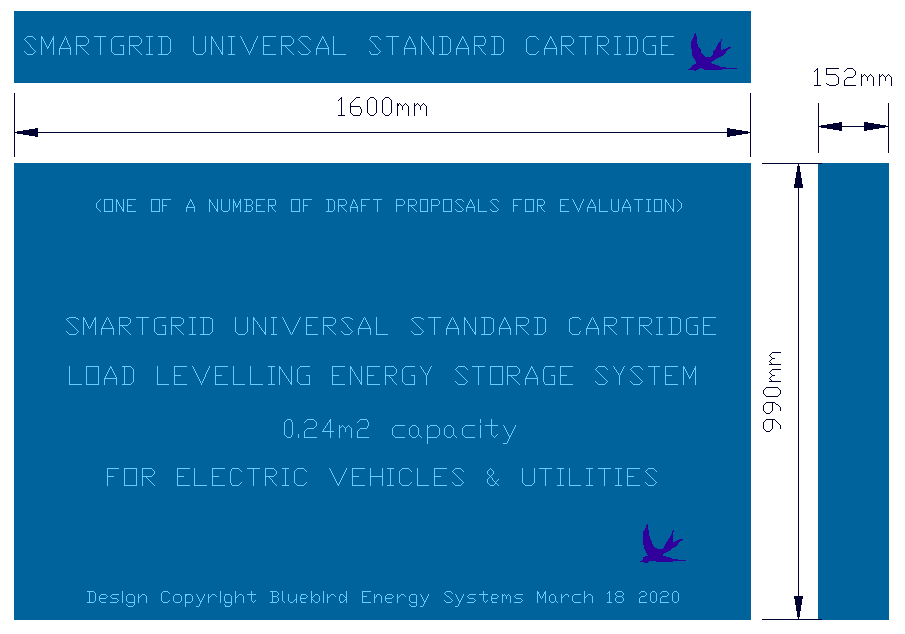|
HYDROGEN EUROPE
Please use our A-Z INDEX to navigate this site where page links may lead to other sites
|
|
|
Vice-President Maroš Šefčovič - The EU Battery Alliance is helping to join up the dots in support of local suppliers and manufacturers, by way of a separate technology camp. The former lack of battery industry in Europe is going to need all the incentives the Commission can muster after years of decline. The Commission are also backing hydrogen. They can of course combine the two, and hedge their bets.
'Hydrogen Europe' represents the European industry, national associations and research centers active in the hydrogen and fuel cell sector. The association partners with the European Commission in the innovation programme Fuel Cells and Hydrogen Joint Undertaking (FCH JU). They are promoting hydrogen as the enabler of a zero emission society.
The positives for a hydrogen based economy is that the gas may be produced using clean, renewable electricity that is generated by solar (photovoltaic) farms, wave energy and wind turbines in what many perceive as a continuous cycle of life based on water and hydrolysis, the means by which hydrogen and oxygen are separated from the liquid compound state into their constituent gases.
Once produced, hydrogen can be stored relatively cheaply in compressed form, with quite a bit more cost attaching to liquefied form. So far so good.
You must admit that it sounds glorious, and it is, except for the drawbacks.
CHINESE SUBSIDIES - Local and national subsidies to support Fuel Cell (FC) powered vehicles in 2018 is estimated @ $12.4bn. China was for a FC fleet of 8,000 by 2018 and 1 million FC vehicles by 2030.
The US leads the way with 4,500 (source: International Energy Agency) on the road in 2018. The US target for 2030 is 800,000 (IEA). Given these figures, it is not surprising that Europe wants to get a look in for fear of missing something. The important thing to consider is the level of subsidy. The Bush administration also subsidized hydrogen fuel cell research enormously.
HYDROGEN DRAWBACKS
There are three main drawbacks:
1. The first drawback is safety, but even this could be overcome at a cost, except perhaps in the long run, where human error and maintenance issues may creep in leading to the loss of human life from fire or explosion. And yes, that could be said for petrol, except that there are almost no recorded instances of a petrol station exploding (except in the movies). There are very many instances of petrol cars catching fire. The good news being that they don't explode, meaning that passengers survive.
2. The second drawback is that Fuels Cells (FCs) are needed to convert the stored hydrogen into electricity. These FCs are not cheap and have a limited life - just like batteries - and this is where hydrogen loses its storage cheapness. Until the re-conversion expense, hydrogen was way out in front in terms of cheap energy storage. Despite this, is has a place in a clean society.
3. The third drawback is conversion efficiency. Unfortunately, this might never be overcome. Put simply the Miles Per Hectare (MPH), or Kilometers Per Acre (KPA if you prefer), as in the miles or kilometers traveled by an EV in relation to the land area needed to harvest energy, is considerably lower going the hydrogen route, than going the battery route. Yes, you lose around 60% of the total input energy - or recover 23% as opposed to 69% for a comparable battery vehicle. Not good, but then the energy from nature is free. Isn't it?
No, the energy from nature is not free. Nothing in life is free where there are state controls. If you want freedom, find an unspoiled island somewhere in uncharted waters. Good luck with that! Planet earth was staked and claimed long before you were born. Solar and wind farms have a cost and a limited life span. You are trebling the cost of the energy capture means going the hydrogen route, but it is better to capture and store what would otherwise be lost - in terms of capacity - where it is the storage capacity that is lacking.
Another reason to use hydrogen for fuel is the energy density, hence range that suitably designed fuel tanks could offer to long haul trucks. This is what Bluebird Energy Systems and the Climate Change Trust are developing alongside battery storage. Hydrogen Cartridges that exceed the performance of Battery Cartridges.
Land area is under constant pressure from agriculture, industry and housing. That means that land has a cost, no matter where it is located, except perhaps for offshore, but even then a State will want paying for licences to operate. Speculators will also come into the frame, putting another spanner in the works - ramping up land values yet more, immoral though that may be, it is not illegal.
FINANCIAL TIMES JAN 2019 - Beijing has spent an estimated $58.8bn subsidising its electric car industry over the past decade, according to the US-based Center for Strategic and International Studies, creating the world’s largest market for electric cars as well as a dominant position in batteries— surpassing Japan and South Korea. Subsidies have also helped propel Chinese solar makers into the ranks of the world’s largest producers, overtaking competitors in the US and Europe.
Randy MacEwen, chief executive of Canada’s Ballard Power, one of the world’s largest fuel cell manufacturers, is quoted as saying: “If you look at what China did in solar, in wind and in battery electric vehicles the subsidy tap was opened and it brought a lot of capital and companies to these new markets, which resulted in China being the leader in all three of these segments,” “We expect to see something similar with the fuel cell industry.”
As the competition hots-up, while hydrogen production might seem like a good idea at the moment, it will fail as a commercial proposition when it comes to energy cost per square kilometer - or as we like to call it Miles Per Hectare (just because we like the acronym MPH) as opposed to battery storage, but could rebound again in many years time when the raw materials can no longer be recycled for batteries and hydrogen production becomes cheaper. At that point hydrogen gives us a backstop, and hang the expense.
If we can afford to wait that long - no worries. If we want a practical solution for the next 50 years within 10 years, it may be that we should go the battery route and build compatibility into our vehicles and service facilities.
EUREKA - Hydrogen is the most abundant element in the universe. With the "green-energy" craze and talk of powering our future oil-free economy on hydrogen, it has received much attention in the last few decades. Learning about this potential fuel of the future is important and interesting, but not without snags, and these are for anyone to seek to overcome. Don't forget the bean counters. It's all down to the money!
FOOL CELLS
Tesla co-founder and CEO
Elon Musk has dismissed
hydrogen
fuel cells as “mind-bogglingly
stupid,” and that is not the only negative thing he has had to say about the technology. He has called them “fool cells,” a “load of rubbish,” and told Tesla shareholders at an annual meeting
that “success is simply not possible.”
But the
Toyota executive added that hydrogen is a viable alternative to
gasoline. Toyota chairman Takeshi Uchiyamada told
Reuters at the same
Tokyo
auto show in
2017, “We don’t really see an adversary ‘zero-sum’ relationship between the EV (battery powered electric vehicle) and the hydrogen car. We’re not about to give up on hydrogen electric fuel-cell technology at all.”
EURACTIVE
10 MARCH 2020
“The Alliance will build on existing work to identify technology needs, investment opportunities and regulatory barriers and enablers,” the Commission said in a statement today, outlining “a new industrial strategy for Europe“.
Hydrogen is “a clear candidate” for an EU-wide initiative aimed at promoting home-grown production of clean gases in support of the bloc’s objective of becoming the first climate-neutral continent in the world by 2050, an EU official told EURACTIV.
The new “Clean Hydrogen Alliance” is set to see the light in the summer, the official said, explaining the initiative enjoys broad backing from EU member states and companies involved in the hydrogen value chain.
The initiative will be modeled on the European Battery Alliance, which brought together more than 200 companies, national governments and research organisations around battery manufacturing.
“We should be ready before or just after the summer break,” the official told EURACTIV, saying the alliance has generated great interest from many EU member states as well as a wider “community” of industries and research organisations.
Germany and the Netherlands are among the EU countries that have signalled the strongest interest in hydrogen, seen as a potential silver bullet to cut emissions from heavy industries such as steel making, cement and chemicals.
Last month, Germany floated a draft hydrogen strategy, announcing plans to promote the clean gas in transportation, and pour millions of euros into research to develop the technology. Berlin is expected to unveil its final strategy on 18 March, just months before it takes over the EU’s six-month rotating presidency, on 1 July.
A novel approach to industrial policy
The European Commission has already tried pushing an industrial policy but previous attempts have failed because of diverging national interests.
While France and Germany are keen to promote national “champions”, smaller countries have resisted those attempts, insisting that strict enforcement of EU competition and state aid rules is crucial to protect smaller players and prevent big companies from taking dominant positions on the EU market.
The EU’s novel approach to industrial policy, already successfully tested with batteries, aims to break the impasse by considering an entire product value chain – from raw materials extraction to manufacturing – in a few strategic sectors.
The hydrogen alliance will be “similar to what we did with batteries,” an EU official told EURACTIV, citing electrolysers as an obvious area of interest for EU manufacturers. “We also need an infrastructure” to produce, transport and store the hydrogen, the official pointed out.
But that doesn’t mean EU competition rules will be thrown out of the window, another official explained, saying strong European champions will not emerge if the EU protects them from competition.
Rather, the Commission intends to adapt the rules on a case-by-case basis, when the situation requires, looking at the “geostrategic” environment in which European companies operate.
“The single market is key. This is the domestic market that you offer” to big and small companies to expand in some strategic industries, the official said.
Important Projects of Common European Interest (IPCEI)
EU officials pitched a “very practical” approach to industrial policy based on a detailed analysis, “ecosystem by ecosystem”, in order to promote the emergence of European champions in strategic sectors and help them compete on the global stage.
“Each of those ecosystems faces very different challenges,” a senior EU official explained, saying the Commission will mobilise all its regulatory arsenal in support of strategic sectors like hydrogen. “We need to adjust our tools and their use depending on the reality of the specific ecosystem,” he said.
Among the key new instruments in the Commission’s “toolbox” are so-called Important Projects of Common European Interest (IPCEI). Normal EU state aid rules won’t apply to projects benefiting from IPCEI status, meaning national governments will be able to subsidise them without having to observe strict state aid limits.
“The Commission will put in place revised state aid rules for IPCEIs,” the Commission confirmed in a statement, saying they will “allow member states to fund large-scale innovation projects across borders which could otherwise not be funded because of market failure”.
The revised state aid rules are expected to be in place in 2021, the Commission said in its industrial policy communication.
PROJECTS - The location of European hydrogen projects are shown on this map. The transport sector is responsible for a quarter of the EU's greenhouse gas (GHG) emissions, so drastic changes in the transport sector are required to meet the 90% reduction in GHG emissions set out in the Green Deal. It is, therefore, vital to completely decarbonise the truck sector to meet the EU objectives.
Hydrogen and energy-intensive industries
Hydrogen is among the strategic industries expected to benefit from the new IPCEI status.
In November, an EU Commission expert group made recommendations on how to develop IPCEIs in six strategic and future-oriented industrial sectors: Connected, clean and autonomous vehicles; Hydrogen technologies and systems; Smart health; Industrial Internet of Things; Low-carbon industry; and Cybersecurity.
“We have made a good start in areas such as batteries, plastic recycling and high-performance computing,” said Elżbieta Bieńkowska, the EU Commissioner in charge of the internal market, industry, entrepreneurship and SMEs. “And we can do more,” she added in a statement back in November, citing hydrogen as one of the industries set to benefit from IPCEI status.
The Commission sees hydrogen as key to cut emissions from process industries such as steelmaking, cement or chemicals, which are considered “hard-to-abate” because they require high-temperature heat and cannot easily be electrified.
The Commission’s principal adviser on energy, Tudor Constantinescu, says “hydrogen may be a missing link in the energy transition” because it can help decarbonise process industries and heavy-duty transport: aviation, maritime and long-haul trucking.
And before these technologies become competitive, they will need support, he said. “In order to help them develop viable business models, you could loosen state aid rules in order to allow direct subsidies for these kinds of products or by subsidising the consumers of these products,” Triangle said in reference to the steel sector.
“The European Commission has already done this with the Battery Alliance and will now do it for hydrogen,” Triangle told EURACTIV. “And the same model could be replicated in other areas as well under the IPCEI label. There is huge potential there.”
EFFICIENT LOAD LEVELING - Why not have a service station for trucks and cars, that can use almost any fuel in a Standard energy cartridge? The keys to this design are simplicity and versatility. The station itself is designed to be solar powered. It might serve lithium based battery cartridges, hydrogen cartridges, or any newly developed storage chemistry - by way of future proofing the EU's transport infrastructure. Compatibility is the name of the game. There is no need to take sides.
Industry groups enthusiastic
Industry associations were enthusiastic about the Commission’s announcement.
“One of the most strategic technologies in the field of hydrogen are electrolysers” which split water into oxygen and hydrogen using renewable electricity, said Hydrogen Europe, a group representing more than 200 companies and research institutions involved in the technology.
“We are still leading as Europeans. But especially China is challenging that position. A Hydrogen Alliance would definitely help to boost the European industries,” said Jorgo Chatimarakis, the Secretary General of Hydrogen Europe, announcing the forthcoming launch of a “2×40 Gigawatt Green Hydrogen Initiative” to underpin this target until 2030.
Eurogas, a trade group, also welcomed the Commission’s initiative, saying the EU hydrogen strategy is “a great opportunity to deliver Europe’s commitment to developing renewable and decarbonised gas”.
“The hydrogen alliance must be about maintaining EU leadership in clean technologies as we are the pioneers in manufacturing electrolysers, CCS equipment and pyrolysis,” Watson said.
The oil and gas industry is among the most fervent supporters of hydrogen because it offers oil and gas firms a segway into cleaner fuels, while drawing on their existing gas production, transport and storage facilities.
“Today, 70% of hydrogen production comes from natural gas. If we decarbonise it with CCS, we can create hydrogen value chains and a market that will reduce costs and help integrate hydrogen from renewable electricity,” said François-Régis Mouton, Europe director at the International Association of Oil and Gas Producers (IOGP).
“Hydrogen and CCUS are the two faces the same coin,” Mouton continued. “This is why we co-signed a call for the recognition of CCS in the EU’s Industrial Strategy, and why we commissioned along with 17 other organisations the ‘Hydrogen for Europe’ study which will identify the potential, costs, barriers, and necessary policies to scale up hydrogen in Europe”.
The results of the study are expected by the end of 2020, and will inform the debate across Europe, Mouton said.
The big challenge now will be to ramp up production, in order to create a market for hydrogen, which is currently almost entirely produced from natural gas, a fossil fuel.
“This is what the platform should focus on: supporting the deployment of such processes with the aim to increase the volumes of hydrogen,” said GasNaturally, an industry campaign group.
Fuelled by a large new wind farm off the coast of Groningen province, the plant would ultimately be able to produce 800,000 tonnes of hydrogen by 2040, the companies said, cutting the Netherlands’ CO2 emissions by about 7 megatons per year.
“Wind is the playmaker of the Green Deal,” said Giles Dickson, the CEO of WindEurope, a trade association. “It’ll power the decarbonisation of the energy system. It’ll drive delivery of strategic EU initiatives such as hydrogen production and smart mobility.
“So wind has to be recognised as one of Europe’s top strategic value chains.” By Frédéric Simon
HYDROGEN SAFETY CARTRIDGE - This cartridge format provides 0.24 of a meter cubic capacity for any energy storage medium, including hydrogen and other fuel cells. All of these formats can be used in multiples to provide up to 1.92 of a cubic meter capacity. This is one of a number of size cartridges that the Cleaner Ocean Foundation will be evaluating as part of a study they hope to obtain funding for ASAP. There is after all a climate emergency. How urgently the EC, UN and G20 rate the urgency of the situation is beyond their control, but judging by the membership of the various alliances (battery and hydrogen) and the WEC, it seems they might mean business. After a survey of vehicles and fine tuning of the best fit, aiming for 90% of existing vehicle platforms, we should have an energy cartridge that will see us into the Age of Clean Transport (ACT), but only if we ACT now.
CONTACT CLEANER OCEAN FOUNDATION & BLUEBIRD ENERGY SYSTEMS
We are interested in working with
'Hydrogen Europe' members, looking forward to the eventual cost effective mass production of a
hydrogen cartridges, alongside battery cartridges for our SmartNet, electric
vehicle service stations:
CONTACTS
LINKS & REFERENCE
https://ec.europa.eu/info/sites/info/files/communication-eu-industrial-strategy-march-2020_en.pdf https://www.euractiv.com/section/energy-environment/news/eu-announces-clean-hydrogen-alliance-for-launch-in-the-summer/ http://www.fch.europa.eu/ https://www.kpmg.us/ https://h2me.eu/ https://hydrogeneurope.eu/
Please use our A-Z INDEX to navigate this site
This website is provided on a free basis as a public information service. copyright © Climate Change Trust 2020. Solar Studios, BN271RF, United Kingdom.
|
